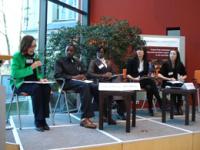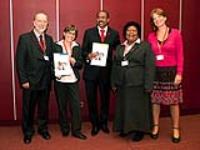A version of this story was first published at www.worldbank.org
Small stipends paid directly to young girls have had a powerful impact on their school attendance in Malawi, reducing drop-out rates considerably and helping to protect them from HIV. That’s among the findings from a study, supported by the World Bank, of a two-year cash transfer programme targeting girls aged 13 to 22 that wrapped up in December 2009.
Stipends ranging from $1-$5 a month for the adolescent girls, in addition to payments to parents that ranged from $4-$10, reduced drop-out rates by approximately 40 percent.
And, for every extra dollar a girl received above $1, “enrolment increased by a percentage point,” says Berk Özler, a senior economist with the World Bank’s Development Research Group.
Özler and fellow researchers Sarah Baird of The George Washington University and Craig McIntosh of the University of California, San Diego, wanted to test the best way to use cash payments known as conditional cash transfers to boost school enrolment among young women in sub-Saharan Africa.
Drop-out rates are high among teenage girls in Malawi, one of the poorest countries in Africa. One of the main reasons is the relatively high cost of secondary school. Another is that Malawian girls tend to marry at a young age, and “once a girl is married, schooling is over,” says Özler.
Keeping girls in school who otherwise would have dropped out may not only increase learning, but delay marriage and reduce the rate of teenage pregnancy and sexually transmitted infections. Adult HIV prevalence in Malawi is around 12 percent, according to UNAIDS estimates.
Staying in school is part of an effective ‘social vaccine’ with respect to sexual risk behaviour.
Patrick Brenny, UNAIDS Country Coordinator in Malawi
In another paper, researchers found that the onset of sexual activity was significantly delayed among girls who took part in the programme, and their likelihood of being married or pregnant after one year had declined.
Past studies have suggested that “just the fact of being in school may lead to these desirable outcomes but the evidence was scant,” Özler says.
These current findings reinforce UNAIDS’ evidence-based contention that girls continuing their education greatly lowers their vulnerability to HIV. For those who stay in secondary school, each additional year means they are more likely to develop the skills and experience needed to keep themselves safe from HIV.
According to Patrick Brenny, UNAIDS Country Coordinator in Malawi, the study underlines the critical necessity of a comprehensive approach to reducing young women and girls' risk and vulnerability to HIV infection in Malawi.
“Staying in school is part of an effective ‘social vaccine’ with respect to sexual risk behaviour,” said Mr Brenny.
Empowering young people to protect themselves against HIV is one of the nine priority areas in the UNAIDS Outcome Framework 2009-11.
Cash transfers boost schooling, nutrition
In countries without adequate safety net support, children’s nutrition often suffers, and children, especially girls, are taken out of school. In an attempt to counteract this trend, some 29 developing countries have put in place some type of conditional cash transfers programme to boost schooling and nutrition, with many others planning on piloting one.
The World Bank backs conditional cash transfers programmes in 13 countries. It provided $2.4 billion to such initiatives in 2009 during the global economic crisis. Studies have found that cash payments to the female head of household leads to better outcomes for children and families. In Brazil, for instance, the chance of childhood survival increases by 20 percent.
But the effect of cash payments made directly to girls versus parents had not been studied until now.
Support to girls ‘makes sense’
In Malawi, the researchers wanted to find out whether the monetary amount of the cash transfer would make a difference, and whether making the payment conditional on school attendance would have an additional impact. They also wanted to test whether making payments directly to girls would affect the outcome.
The study involved a sample of 3,805 girls and young women aged 13 to 22 in 176 urban and rural areas in Zomba, a highly populated district with high dropout rates and low educational attainment. According to a 2005 government survey, children drop out of school mainly due to financial hardship.
Of these girls, a randomly selected group of 1,225 were either offered stipends on the condition they attend school 80 percent of the time, or offered the same stipends unconditionally. The rest did not receive any offers and served as the comparison group for the study.
Girls getting the monthly stipend participated in a lottery where they picked a bottle cap out of an envelope to win an amount between $1 and $5 a month. Guardians were also randomly assigned a separate amount ranging from $4 to $10 a month. On average, girls received $3 and their parents $7, meaning that cash payments to both girls and guardians totalled an average of $10 a month, but ranged from $5-$15.
Each household received an informational sheet detailing the amounts and conditions of the offer, if there were any, and the contract was signed by the girl and her guardian.
Özler says that the condition to attend school at least 80 percent of the time did not seem to make a difference to schooling outcomes in Malawi, nor did increased total cash payments above the minimum of $5 per month. That’s in contrast to the CCT experience in Latin America, where the condition to attend school has been key to the programme’s success.
The girls, however, were demonstrably motivated by their stipends, which they mostly spent on personal items such as clothing.
“The study was successful in getting dropouts to come back to school and in keeping girls in school. Maybe it makes sense to directly support adolescent girls,” says Özler.
The researchers are now conducting follow-up tests and surveys in Malawi to assess, among other things, the impact of the programme on maths and reading skills.
The study was funded by the Global Development Network; the Bill & Melinda Gates Foundation; the World Bank’s Gender Action Plan, Knowledge for Change Trust Fund, World Development Report 2007 Small Grants Fund, Spanish Impact Evaluation Fund, and Research Group; and the National Bureau of Economic Research in the United States.




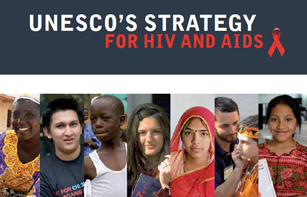

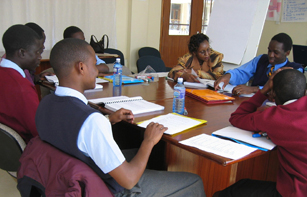
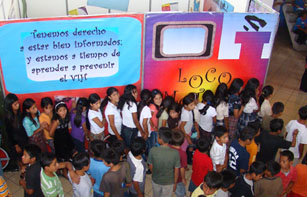

 Right for you! satellite. Credit: UNAIDS/Anna Rauchenberger
Right for you! satellite. Credit: UNAIDS/Anna Rauchenberger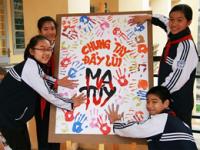 “This is a unique experience with the UN I’ve never seen elsewhere,” said Lisa Sherburne, an HIV specialist with Save the Children. Credit: UN
“This is a unique experience with the UN I’ve never seen elsewhere,” said Lisa Sherburne, an HIV specialist with Save the Children. Credit: UN

